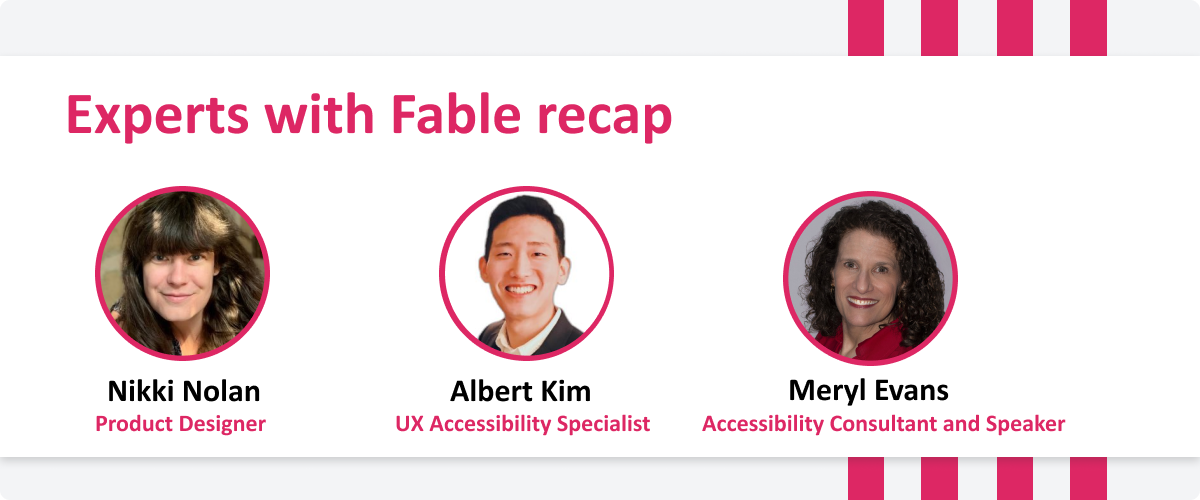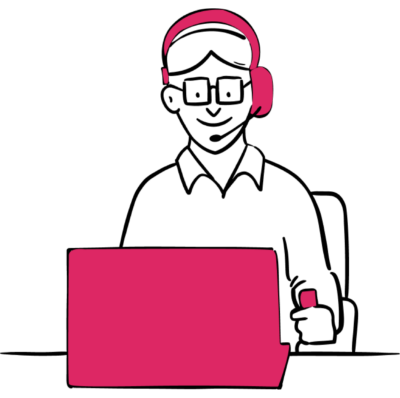
Experts with Fable recap
How to avoid surface-level inclusion of people with disabilities in tech
Experts with Fable is an ongoing webinar series where UX designers, researchers, product managers, engineers and accessibility professionals from leading companies discuss their digital accessibility projects, lessons, and strategies. To stay in the loop about future Experts with Fable, follow us on LinkedIn or sign up for our newsletter.
There has been a lot of discussion and work on the hiring of people with disabilities in the workplace, and some progress has been made. Companies are setting hiring targets and starting to think about how they can bring people in, making recruitment processes accessible and creating diverse teams. But beyond a wider HR perspective, let’s discuss how to include people with disabilities on our team and in our actual work.
This time, Samuel Proulx, Accessibility Evangelist at Fable sat down with Nikki Nolan, Albert Kim and Meryl Evans to share their experiences and best practices. Nikki Nolan is an award-winning product design leader, Albert Kim is Accessibility Lead at Korn Perry and subject matter expert on cognitive disabilities, and Meryl Evans is a global speaker and trainer for companies focused on diversity, equity, and inclusion.
30% of the workforce fits within the definition of disability
A Harvard Business Review article says that 30% of the workforce fits the federal definition of having a disability. Yet, only 39% of people with disabilities have disclosed it to their companies.
“Companies have a gap in their workforce. They’re missing the innovative and different way of thinking for coming up with creative solutions they’d get from hiring people with disabilities. Considering only 20% of people with disabilities are employed (Bureau of Labor Statistics) this is a huge untapped market. 80% of people said the number one barrier to employment is their own disability.” – Meryl Evans
The COVID-19 pandemic brought attention to disability needs
There are impacts to mental health, including in the workplace, worldwide.
“There’s a possible mental health impact and mental health disability, in the next wave of COVID.” – Albert Kim
Companies saw a dramatic increase in video meetings.
“I’ve been a remote worker for 17 years. Before the crisis, I might’ve done up to five video calls. Since COVID? I’ve had more than five video calls this week. The pandemic was the catalyst for companies to add captions to their platforms.” – Meryl Evans
Mental health is tied to physical health
Avoid perpetuating mental health stigma in the workplace and recognize that mental and physical health are equally important to the support and success of your team. Also, people are not alone – scientists say the number of people dealing with mental health issues in the world is 10.7% or 792 million.
“While the brain represents just 2% of a person’s total body weight, it accounts for 20% of the body’s energy use. Studies show that it is also impacted by the bacteria in your intestine…there’s a huge correlation between depression and the probiotics in your digestive system.” – Albert Kim.
Accommodations don’t have to be costly
Avoid thinking that disability accommodation equals costliness as it is not true and directly damaging to people with disabilities. People may not ask for accommodations out of fear of the perceived cost or effort.
Instead, focus on the value of diversity and how this translates to financial gains that can actually fit within work environments. It’s important to avoid an ableist view or gender bias which have been barriers for some.
Getting started as an organization
Build a workplace culture that supports authenticity
“I’ve always been authentically myself. This hasn’t really fit within every system. I like to describe myself as a squiggly line, but I have found it really hard to be a squiggly line in a world (of circles) that doesn’t support being squiggly.” – Nikki Nolan
Allow people to be their authentic selves. This avoids people with disabilities resorting to “masking” as a survival technique strategy to fit in with the environment or situation. This can include such behaviors as forcing eye contact during a conversation or imitating smiles or facial expressions. Many people with invisible disabilities don’t self-report their disabilities.
“I learned early on at work that in order for me to move forward, I needed to present as a neurotypical person. As soon as I interacted with a different system, I was allowed to be “a squiggly line”.” – Nikki Nolan
Establish an HR accessibility champion
Ensure that your HR team has an accessibility champion. Their job is to be a resource for the entire company as well as candidates and new employees with disabilities.
Avoid making assumptions about accommodations and alternatives
“I asked not to write a form as I am dyslexic. I was offered text-to-speech software. However, this not how I work, and would’ve required me to learn a whole new technology – a barrier to overcoming another barrier.” – Nikki Nolan
HR systems and process can be complex and a lot of the time, there’s a third-party that handles the accommodation. It’s good to simplify the process by asking what people need.
“Don’t just wait for a disabled person to tell you what to do. Offer multiple ways to solve a problem. You’ll get more creative ideas this way. Also, know that one solution will not solve all problems. Listen to people and have the flexibility to change.” – Nikki Nolan
Trust the person knows what’s best for them.
“Give people time and space to do what they need to do. It’s very challenging for people with mental health disabilities to request for accommodations, because people often think that “That’s an excuse”.” – Albert Kim
Invest in accessible software
Buy software that meets strong accessibility requirements. Use your power as a company to uplift and force technology companies to be better. A lot of companies are starting to make this is a requirement in the procurement process.
When doing so, consult with people who have lived experience.
Make your hiring process accessible
- Provide accessibility training for your HR staff and across your organization. About 15% of people with disabilities say this is a barrier for them in the workplace.
- Make sure your job application platforms are accessible so they don’t lock out qualified people who happen to have a disability.
- If you have videos on your website, ensure they have captions.
- Ensure screen reader users can navigate your website.
- If you have images on your marketing website, they reflect the diversity of employees in your organization.
- Make sure all marketing content is in accessible formats, including websites, videos, images, and PDF documents.
- To show you have a culture of inclusion, position descriptions need to incorporate what the person is responsible for in terms of accessibility and inclusion.
Offer multiple formats of communication
Offer multiple formats of communication in the hiring or promotion process. For example, avoid requirements to write a lot of content in an application form, or the only way to connect is through a phone call, for an interview as part of the hiring process, or on the job for internal meetings.
Neurotypical people can ask and learn how neurodivergent people communicate, beyond a technical accommodation. Avoid asking for an excess amount of documentation to prove that the accommodation is needed.
“Deafness is a spectrum. Some people sign, some don’t. Some do both. Some read lips, some don’t. Some wear hearing devices, some don’t. Some talk, some don’t. The possibilities are endless! That’s why it’s so important to ask and not to make assumptions.” – Meryl Evans
Creating an inclusive culture
Be genuine in your advocacy
“We as people with disabilities, absorb the same negative biases about ourselves that are out there in the regular world. Making sure that, for me, that I’m uplifting everybody else’s voices.” – Nikki Nolan
For some people, there is a process of deprogramming in their own minds that disability is negative. They just see people as people, and also to see themselves as just a person with an invisible disability.
Avoid perpetuating bias or negativity in the workplace when it comes to disability and create a safe space.
“Start following disabled creative people. Learn the language of all these different cultures. And don’t take up the space, just sit and observe without interjecting your opinion.” – Nikki Nolan
Recognize that people are still learning about themselves and their own needs.
“Where I’m from, mental health is huge taboo which means it is very challenging for me to go through that mental health disability journey. It took me a long time to accept my own disabilities and that mental health is real and that it is okay to have them, and it is okay to acknowledge them.” – Albert Kim
Learn and avoid triggers for people with mental health disabilities.
In the tech industry, team communication and collaboration can take many forms: in-person Agile development SCRUM meetings, one-on-one check-ins, performance reviews, group meetings. Give people the ability to opt out if they need to.
“Give them option to opt out. And especially for new people who are onboarding, think about gradual progress rather than asking for performance from the first quarter. People with mental health disabilities take time to get adjusted.” – Albert Kim
Avoid negative speech and tones, and focus on building a positive, encouraging and supportive environment. Negative feedback is never a long-term, sustainable, people management skill.
“It’s best to use positive feedback more in the language that you speak, e.g. soft language. Also, politics, drama, and group dynamics are probably the most stressful and least inclusive culture that you can build for people with mental health disabilities.” – Albert Kim
Conclusion
The best way to ensure your products and services are accessible is by involving people with disabilities early in the design before you create anything. “Shifting left” means moving accessibility early in the development process and involving people with disabilities throughout the entire process, to go beyond surface-level inclusion. Better yet, the best way is to hire people with disabilities in tech.
“You may have heard the phrase, “Nothing about us without us.” But I encourage you to take it a step further and make it “Nothing without us”.” – Meryl Evans
Watch the full webinar to learn more from Nikki, Albert, and Meryl
Learn more about accessibility testing and training
Questions about how you can bring insight from people with disabilities into your product design and development cycle?

